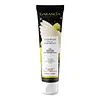What's inside
What's inside
 Key Ingredients
Key Ingredients

No key ingredients
 Benefits
Benefits

 Concerns
Concerns

 Ingredients Side-by-side
Ingredients Side-by-side

Water
Skin ConditioningDisodium Lauryl Sulfosuccinate
CleansingGlycerin
HumectantCitrus Limon Fruit Extract
MaskingZinc Coco-Sulfate
CleansingDisodium Capryloyl Glutamate
CleansingSodium Lauroyl Sarcosinate
CleansingSulfur
AntiseborrhoeicZinc PCA
HumectantSodium Chloride
MaskingCucumis Sativus Fruit Extract
EmollientUrtica Dioica Leaf Extract
Skin ConditioningHelianthus Annuus Seed Oil
EmollientCI 75120
Cosmetic ColorantButylene Glycol
HumectantXanthan Gum
EmulsifyingPropylene Glycol
HumectantPotassium Sorbate
PreservativeSodium Benzoate
MaskingParfum
MaskingWater, Disodium Lauryl Sulfosuccinate, Glycerin, Citrus Limon Fruit Extract, Zinc Coco-Sulfate, Disodium Capryloyl Glutamate, Sodium Lauroyl Sarcosinate, Sulfur, Zinc PCA, Sodium Chloride, Cucumis Sativus Fruit Extract, Urtica Dioica Leaf Extract, Helianthus Annuus Seed Oil, CI 75120, Butylene Glycol, Xanthan Gum, Propylene Glycol, Potassium Sorbate, Sodium Benzoate, Parfum
 Reviews
Reviews

Ingredients Explained
These ingredients are found in both products.
Ingredients higher up in an ingredient list are typically present in a larger amount.
Parfum is a catch-all term for an ingredient or more that is used to give a scent to products.
Also called "fragrance", this ingredient can be a blend of hundreds of chemicals or plant oils. This means every product with "fragrance" or "parfum" in the ingredients list is a different mixture.
For instance, Habanolide is a proprietary trade name for a specific aroma chemical. When used as a fragrance ingredient in cosmetics, most aroma chemicals fall under the broad labeling category of “FRAGRANCE” or “PARFUM” according to EU and US regulations.
The term 'parfum' or 'fragrance' is not regulated in many countries. In many cases, it is up to the brand to define this term.
For instance, many brands choose to label themselves as "fragrance-free" because they are not using synthetic fragrances. However, their products may still contain ingredients such as essential oils that are considered a fragrance by INCI standards.
One example is Calendula flower extract. Calendula is an essential oil that still imparts a scent or 'fragrance'.
Depending on the blend, the ingredients in the mixture can cause allergies and sensitivities on the skin. Some ingredients that are known EU allergens include linalool and citronellol.
Parfum can also be used to mask or cover an unpleasant scent.
The bottom line is: not all fragrances/parfum/ingredients are created equally. If you are worried about fragrances, we recommend taking a closer look at an ingredient. And of course, we always recommend speaking with a professional.
Learn more about ParfumSulfur is a commonly occurring element on Earth (and our universe!). In cosmetics, it helps kill bacteria, reduces sebum, and provides exfoliation. This makes it an effective ingredient to reduce breakouts and fight acne.
As a ketayolytic agent, it breaks down the top layer of skin. This is a form of exfoliation and may help decrease acne and hyperpigmentation.
Studies show sulfur has antibacterial and antifungal properties. Sulfur can be drying if used excessively or at higher concentrations. We recommend speaking with a medical professional if you have any concerns.
Ancient Greece, India, China, and Egypt have used sulfur in both traditional medicines and for household use.
Learn more about Sulfur